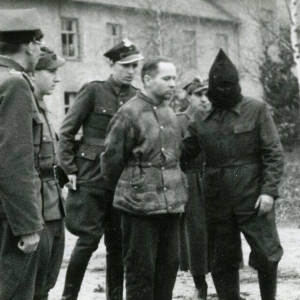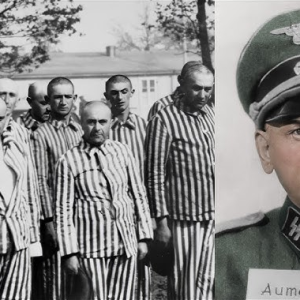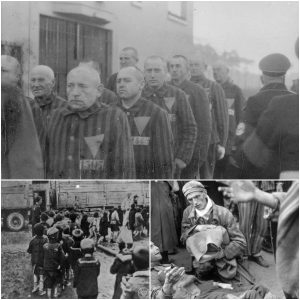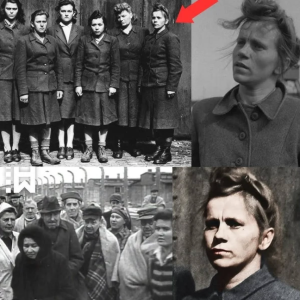
In the shadows of the Holocaust, where humanity’s darkest impulses were unleashed, figures like Gertrude Saurer emerge as chilling reminders of ordinary people turned instruments of terror. Known among survivors for her sadistic cruelty, Saurer served as a female guard (Aufseherin) in the Nazi concentration camp system during World War II. She was one of the many women who, under the SS banner, enforced the regime’s genocidal policies at Bergen-Belsen, a camp synonymous with unimaginable suffering. Convicted at the Belsen Trial in 1945 and sentenced to 10 years in prison, Saurer’s story exposes the complicity of women in the Nazi machinery of death. This article explores her background, wartime actions, trial, and legacy, offering fans of dark history a gripping, detailed look into one of the lesser-known yet profoundly disturbing perpetrators.
Early Life and Path to the SS

Little is documented about Gertrude Saurer’s early years, a common trait among many low-ranking SS personnel whose personal histories were overshadowed by their crimes. Born in the early 20th century in Germany, Saurer likely came from a working-class background, as did most female guards recruited into the SS-Gefolge, the auxiliary organization for women supporting the SS-Totenkopfverbände (Death’s Head Units). The Nazi regime’s expansion of the concentration camp system created a dire need for guards, especially as men were diverted to the front lines.
By 1939, with the outbreak of war, women like Saurer were conscripted or volunteered for service. Training began at Ravensbrück, the primary women’s concentration camp north of Berlin, where recruits underwent indoctrination in Nazi ideology, antisemitic propaganda, and brutal enforcement tactics. Films like Jud Süß were screened to stoke hatred, and guards were taught to view prisoners—Jews, Roma, political dissidents, and others—as subhuman. Saurer, like her peers, would have been instilled with the belief that her role was essential to the “racial purity” of the Reich. Historical estimates suggest around 3,500 women served as Aufseherinnen across the camps, but Saurer’s path led her to Bergen-Belsen, where her reputation for violence quickly solidified.
Service at Bergen-Belsen: A Reign of Sadism
Bergen-Belsen, established in 1940 as a POW camp, evolved into a nightmarish holding site for Jews and other “undesirables” by 1943. Under commandants like Josef Kramer, the camp swelled with tens of thousands of prisoners, leading to rampant disease, starvation, and death. Saurer arrived as an Aufseherin sometime in 1944, tasked with overseeing female prisoners in labor details, selections for the gas chambers (though Belsen had no on-site gas chambers, it facilitated transports to death camps), and daily enforcement of SS discipline.
Survivor testimonies paint Saurer as a particularly vicious guard, earning her a place among the camp’s most feared overseers. She was known for her use of whips, boots, and fists to punish inmates for the slightest infractions—slow work, perceived insolence, or even exhaustion from malnutrition. One account describes her beating women until they collapsed, laughing as she did so, embodying the sadism that permeated the female guard corps. Unlike some guards who claimed coercion, Saurer’s actions suggest enthusiasm for her role; she participated in “selections,” deciding who lived or died based on arbitrary whims, and allegedly stole valuables from the dead, a common but egregious abuse.
As the war turned against Germany, conditions at Belsen deteriorated catastrophically. By early 1945, over 50,000 prisoners were crammed into squalor, with typhus and dysentery claiming thousands weekly. Saurer remained at her post, enforcing orders amid the chaos. When British forces liberated the camp on April 15, 1945, they found 13,000 unburied corpses and survivors on the brink of death. Saurer, along with other guards, was detained immediately, her uniform a symbol of the horror unearthed.
The Belsen Trial: Justice and Reckoning

The Belsen Trial, held from September 1945 to November 1946 at Lüneburg in occupied Germany, was one of the first major postwar proceedings against Nazi personnel. Conducted by British military authorities, it indicted 45 defendants, including 16 women, for war crimes at Bergen-Belsen and associated camps. Saurer was among the female guards on trial, charged with crimes against humanity, including the mistreatment, torture, and murder of prisoners.
The proceedings were marked by harrowing survivor testimonies. Witnesses recounted Saurer’s beatings, her role in forced labor that led to deaths, and her indifference to the starving and sick. Unlike high-profile defendants like Irma Grese (dubbed the “Hyena of Auschwitz” and hanged) or Elisabeth Volkenrath, Saurer was not a senior overseer but her direct involvement in atrocities was undeniable. She denied the charges, claiming she was merely following orders—a defense echoed by many—but the evidence, including camp records and eyewitness accounts, proved otherwise.
On November 17, 1945, Saurer was convicted and sentenced to 10 years’ imprisonment. This was a relatively severe penalty compared to some male guards who received lighter terms, reflecting the court’s outrage at female complicity. She served her time in a British prison, part of a broader effort to hold the SS accountable. The trial set precedents for future Nuremberg proceedings, emphasizing that even low-level functionaries bore responsibility for the Holocaust’s machinery.
Post-War Life and Historical Legacy
Released around 1955 after serving her full sentence, Saurer faded into obscurity, much like many surviving guards who reintegrated into West German society under denazification programs. There are no records of her remarriage or public remorse; she likely lived out her days in quiet anonymity, dying sometime in the late 20th century. Her case highlights the uneven justice of the postwar era—while some like Grese faced execution, others escaped deeper scrutiny due to lost evidence or Cold War priorities.
Saurer’s legacy endures as a stark example of how the Nazi system corrupted women, turning them from civilians into perpetrators. Historians like Wendy Lower in Hitler’s Furies argue that female guards were not anomalies but products of indoctrination and opportunity, challenging postwar myths of women as passive victims. Today, her story serves as a cautionary tale in Holocaust education, reminding us that evil thrives when ordinary people abdicate morality.
Gertrude Saurer’s 10-year sentence for her crimes at Bergen-Belsen was a small measure of justice for the thousands she tormented. Her tale, woven into the fabric of the Holocaust’s female perpetrators, forces us to confront uncomfortable truths: brutality knows no gender, and complicity can wear many faces. As we delve into these histories on platforms like Facebook, may it fuel our commitment to remembrance and vigilance, ensuring such darkness never returns. Share your thoughts—how do stories like Saurer’s change your view of the war?





